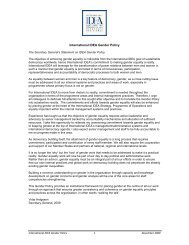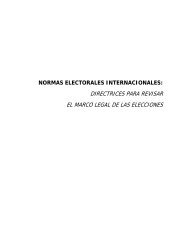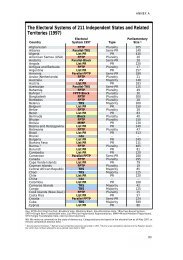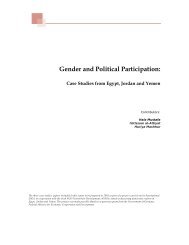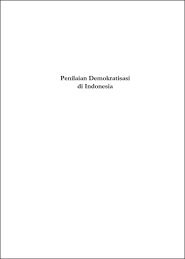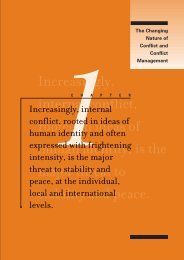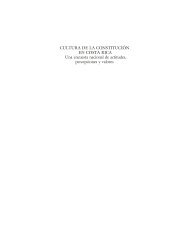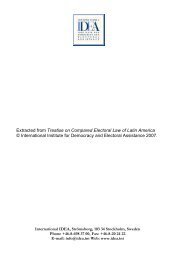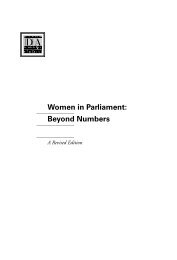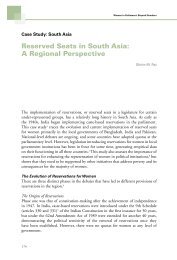The Role of State Constitutions in Protecting ... - International IDEA
The Role of State Constitutions in Protecting ... - International IDEA
The Role of State Constitutions in Protecting ... - International IDEA
You also want an ePaper? Increase the reach of your titles
YUMPU automatically turns print PDFs into web optimized ePapers that Google loves.
Once the draft Australian federal Constitution was approved by the Convention<br />
it was put to referendum <strong>in</strong> each colony. Each colony had a veto, <strong>in</strong> the sense that<br />
it would not jo<strong>in</strong> the federation unless its voters had approved the Constitution.<br />
After a somewhat tortuous process, the Constitution was approved by all six<br />
colonies and was sent to Brita<strong>in</strong>, as the colonial power, for enactment.<br />
<strong>The</strong> issues that divided the colonies<br />
Some <strong>of</strong> the Australian colonies were more enthusiastic about federation than<br />
others. Queensland was too preoccupied with its own affairs to participate <strong>in</strong> the<br />
Convention <strong>of</strong> 1897–98 and therefore played almost no role <strong>in</strong> shap<strong>in</strong>g the f<strong>in</strong>al<br />
form <strong>of</strong> the Constitution. <strong>The</strong> voters <strong>of</strong> the largest colony, New South Wales,<br />
voted aga<strong>in</strong>st the Constitution <strong>in</strong> the first referendum, possibly because the<br />
balance had swung too far towards the <strong>in</strong>terests <strong>of</strong> the smaller colonies. Federation<br />
was impracticable without New South Wales, and some changes were made to the<br />
draft to ensure that the referendum succeeded on the next attempt. Western<br />
Australia hesitated about jo<strong>in</strong><strong>in</strong>g the federation until the last moment. It was<br />
<strong>in</strong>duced to do so <strong>in</strong> part by a special concession <strong>in</strong> the Constitution, applicable<br />
for the first 10 years <strong>of</strong> federation, that gave it some power to cont<strong>in</strong>ue to impose<br />
its own duties <strong>of</strong> customs, despite the exclusive Commonwealth power over duties<br />
<strong>of</strong> customs.<br />
<strong>The</strong>re was basic agreement between most delegates on a number <strong>of</strong> key po<strong>in</strong>ts.<br />
<strong>The</strong>se <strong>in</strong>cluded federation as an appropriate form <strong>of</strong> government for the united<br />
Australian colonies; the broad l<strong>in</strong>es <strong>of</strong> the federal division <strong>of</strong> power; the need for<br />
guarantees <strong>of</strong> <strong>in</strong>terstate mobility and <strong>of</strong> a common market; the creation <strong>of</strong> a<br />
Senate, as an upper House <strong>of</strong> the Commonwealth Parliament, to represent the<br />
<strong>State</strong>s; and the establishment <strong>of</strong> one s<strong>in</strong>gle court (the High Court) as the f<strong>in</strong>al<br />
court <strong>of</strong> appeal with<strong>in</strong> Australia <strong>in</strong> all matters, as an alternative to appeals to the<br />
Imperial Privy Council. <strong>The</strong>y also agreed that the Constitution <strong>in</strong> which these<br />
arrangements would be set down should be relatively hard to change.<br />
But the delegates were deeply divided on many matters as well. Some <strong>of</strong> the<br />
differences were ideological. Thus there were the usual divisions between<br />
progressives and conservatives, which were given a particular focus over particular<br />
issues, such as votes for women. <strong>The</strong>re was another important division between<br />
delegates who supported free trade and those who advocated tariff protection.<br />
Some <strong>of</strong> the most important divisions, however, reflected <strong>State</strong> <strong>in</strong>terests. <strong>The</strong>se<br />
were a response to geography, economic development and, above all, population<br />
size and resultant wealth. In addition, there was at least one issue that united most<br />
<strong>of</strong> the Australian delegates on one side, aga<strong>in</strong>st the British government on the<br />
other. This was the jurisdiction <strong>of</strong> the Privy Council.<br />
Some <strong>of</strong> the ma<strong>in</strong> areas <strong>of</strong> disagreement concerned the Senate. As a generalization,<br />
the less populous <strong>State</strong>s wanted a powerful Senate <strong>in</strong> which the <strong>State</strong>s were equally<br />
represented. <strong>The</strong> larger <strong>State</strong>s, and <strong>in</strong> particular New South Wales, preferred<br />
representation <strong>in</strong> the Senate that reflected population size <strong>in</strong> some way. If equal<br />
31




